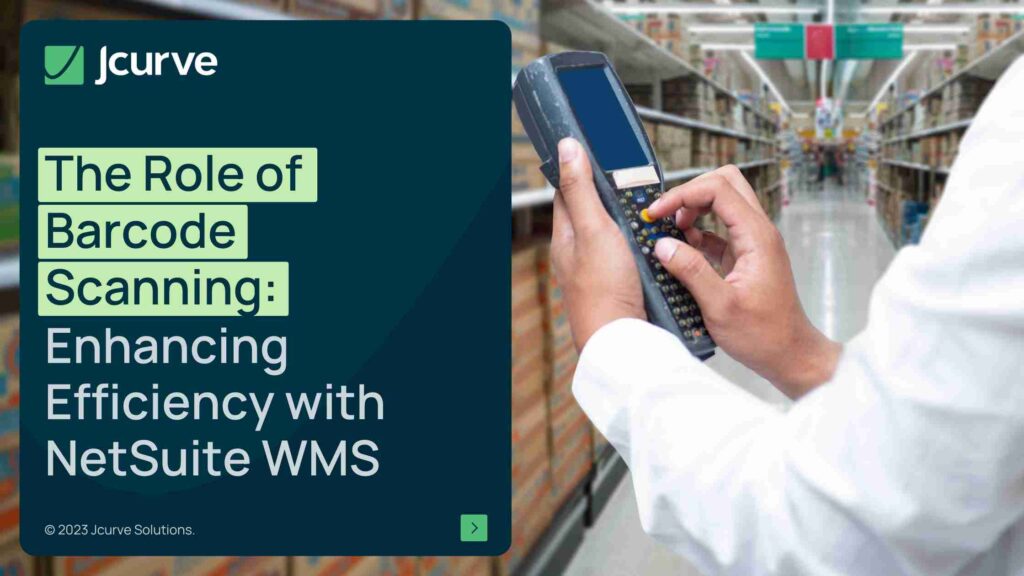In this blog post, we explore the vital role of barcode scanning in optimising warehouse operations and its seamless integration with NetSuite’s Warehouse Management System (WMS). Join us as we navigate the advanced functionalities of NetSuite WMS and uncover how they revolutionise warehouse management.
Understanding Barcode Scanning in Warehouse Management
Barcode scanning has revolutionised the logistics sector. This technology, pivotal in tracking and managing inventory, is a cornerstone of efficient warehouse management. It bridges the gap between physical inventory and digital tracking, providing real-time visibility and control.
Technical Integration of Barcode Scanning with NetSuite WMS
Understanding the technical intricacies of how barcode scanning integrates with NetSuite’s Warehouse Management System (WMS) is crucial for businesses looking to leverage this technology. NetSuite WMS uses advanced algorithms and database management techniques to seamlessly incorporate barcode data.
- Data Capture and Processing: When a barcode is scanned, the system captures data encoded in the barcode and processes it in real-time.
- Database Integration: This data is then mapped to the corresponding inventory items in the NetSuite database, ensuring accurate inventory tracking.
- Automated Workflows: The integration allows for automated workflows, where actions like stock adjustments, order fulfilment, and reorder triggers are executed based on barcode scans.
- Customisation and Scalability: NetSuite WMS offers customisation options to adapt barcode systems to specific business needs. The system is also scalable to handle increasing volumes of barcode data as a business grows.
- Security and Reliability: The integration ensures data security, with robust protocols in place to protect sensitive information scanned from barcodes.
For further details on how NetSuite optimises warehouse operations through technology, consider exploring our comprehensive guide on Migrating to NetSuite WMS: A Comprehensive Guide.
The Integration of Barcode Scanning with NetSuite WMS
NetSuite’s Warehouse Management System is critical in leveraging the full potential of barcode technology. This system acts as a comprehensive database, storing all product information, including barcodes. When a product is scanned, this information feeds directly into the system, updating inventory levels in real-time. This integration ensures:
- Accurate Inventory Management: Barcodes update inventory levels in the NetSuite system each time an item is moved, providing a complete and accurate picture of current inventory levels.
- Efficient Stock Management: Automatic updates prevent stock outages and lost sales opportunities, ensuring constant availability of products.
- Location Tracking: The system records the location of each SKU, enabling faster order fulfilment and reduced labour costs.
- Informed Decision Making: Real-time data allows for better purchasing decisions, enabling businesses to promote the right items and manage slow-moving inventory effectively.
For insights into how these systems can boost your operational efficiency, delve into Boosting Your Warehouse Efficiency with NetSuite.
Advantages of Barcode Scanning in Supply Chain and Warehouse Environments
In the vast arena of supply chain and warehouse management, barcode scanning plays a crucial role. This technology is not just a tool for efficiency; it’s a cornerstone for modern logistics. It brings about several key benefits:
- Optimised Logistics Operations
Barcode scanning streamlines the entire logistics process, from inventory receipt to shipping. It enables quicker processing of goods, reduces handling times and improves overall workflow.
- Enhanced Traceability
One of the critical aspects of supply chain management is traceability. Barcode scanning provides a reliable way to track products throughout their journey, from manufacturer to end consumer. This level of traceability is essential for quality control, recall management and ensuring authenticity.
- Increased Supply Chain Transparency
By offering real-time data on product movement and stock levels, barcode scanning contributes significantly to supply chain transparency. This transparency is vital for managing supply chains more effectively, reducing bottlenecks and making informed decisions.
- Cost Reduction and Efficiency Improvement
By minimising manual data entry and errors, barcode scanning substantially reduces operational costs and enhances operational efficiency. This technology accelerates the entire inventory process, from audits to stock-level accuracy, ensuring both speed and precision. Additionally, barcodes significantly improve inventory management, from swiftly locating items to streamlining the picking and packing processes, thereby reducing overall operational expenses.
To delve deeper into the extensive benefits of barcode scanning in warehouse settings, consider exploring this article, which offers a detailed perspective on the technology’s impact in the logistics sector.
- Improved Customer Satisfaction
The integration of barcode scanning with advanced inventory management systems not only streamlines operations and reduces labour costs but also plays a critical role in enhancing customer satisfaction through precise and swift order processing. In the competitive landscape of today’s market, the ability to process orders quickly and accurately sets businesses apart.
This integration is essential for companies looking to refine their purchasing strategies and maintain a competitive edge. For businesses seeking to leverage these transformative capabilities to optimise their operations, engaging with Jcurve provides a pathway to understanding and implementing these game-changing features.
In summary, barcode scanning is more than just a technological advancement; it’s a transformative tool that brings efficiency, accuracy, and transparency to the supply chain and warehouse environments, making it indispensable in the modern logistics landscape.
Future Trends in Barcode Technology and NetSuite’s Adoption
As we look towards the future of inventory management, trends in barcode technology are evolving rapidly, with NetSuite WMS at the forefront of adopting these advancements. According to recent insights in 2023, one such trend is the increasing use of mobile RF (Radio Frequency) barcode scanning.
- Mobile RF Barcode Scanning: NetSuite WMS incorporates mobile RF barcode scanning, allowing for greater flexibility and efficiency in warehouse operations. This technology enables workers to scan items from a distance, reducing the need for manual handling and speeding up the inventory process.
- Integration with Advanced Technologies: NetSuite is also exploring integration with technologies like RFID (Radio-Frequency Identification) and IoT (Internet of Things), which promise to further streamline inventory management and tracking.
- Enhancing Data Analytics: With these advancements, NetSuite WMS is positioned to offer more robust data analytics, enabling businesses to make more informed decisions based on real-time inventory data.
By staying ahead with these industry-leading practices, NetSuite WMS ensures that businesses are equipped with the most advanced tools for efficient inventory management.
Conclusion
Barcode scanning technology, especially when integrated with NetSuite WMS, is transforming warehouse management. As we look to the future, this harmony between technology and operational efficiency continues to evolve, promising even more advancements in warehouse and supply chain management.










